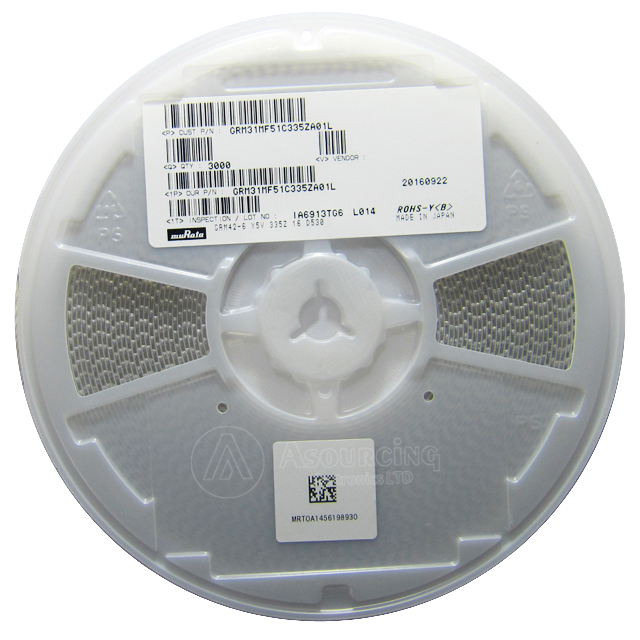Behind the MLCC crazy price increase
Recently, there has been many information about the price increase of MLCC. As a very important device in the electronic industry chain, only a few enterprises in the world can produce high-quality products. Japan's Murata studio, Solar Decoy and TDK, and South Korea's Samsung Motor four companies monopolize more than 70% of the world's MLCC markets.

Why is MLCC so important?
MLCC is also known as chip multi-layer ceramic capacitor, is printed by the electrode of the ceramic dielectric diaphragm stacked together in a dislocation, after a high temperature sintering ceramic chip, and then sealed on both ends of the chip metal layer, thus forming a structure similar to monolith, so called monolith capacitor.

MLCC is called "rise of IT industry" and is indispensable to the electronic equipment industry, because MLCC is an important component to prevent electromagnetic interference, which can be widely used in mobile phones, computers and automotive electronic products. With the capacity bottlenecks of mobile phones and computers, the main market that will support MLCC in the future is automotive electronics, a $10 billion area.
MLCC has numerous functions in automotive electronics, such as storing power and transmitting electrical signals in semiconductors. Because new energy vehicles, autopilot cars and other products demand higher MLCC, which is good for the four giants, because other SMEs are very difficult to produce high-quality products, which directly led to the MLCC crazy price increase.
The development of MLCC products is problematic, which makes it difficult for SMEs to enter.
Small and medium-sized enterprises are difficult to threaten the four MLCC giants because of the characteristics of MLCC and its unique market decision. The author believes that there are set at three reasons for the oligopoly of MLCC products.
1. Where is the production technology of MLCC products?
MLCC products are hard to replace because they are widely used and difficult to develop. Under normal circumstances, the molded MLCC product needs more than 20 processes to get the finished product. From batching, tape casting, printing, laminating, capping to laminate, cutting, glue discharging to sinter, end-jointing, burning end, and finally to test and tape.
The most challenging part of these processes is casting and glue discharging. Ceramic slurry needs to pass through the casting gate of the tape casting machine to be coated on the wound PET film, thus forming a uniform slurry layer. After drying, the thickness of ceramic diaphragm is between 10um and 30um. With a slight negligence, the size cannot meet the customer's standards.
The difficulty of glue discharge process is to place the green capacitor on the baking board, the high temperature baking temperature should be kept not low or high, the common is 400 degrees Celsius, this process is to remove the organic materials such as adhesives in the chip, the precision of the process is super high.
In addition to casting and dispensing, the details of each production process of MLCC products must be strictly controlled, because a tiny mistake may lead to product performance gaps, as the market for high-precision products, capacitor error capacity is very small.

2. the unique market supply characteristics of MLCC products
MLCC products are different from other electronic devices market, in the early MLCC market. MLCC products are not so popular now. MLCC products were successfully developed by American companies in the 1960s, and then rapidly developed and industrialized in Japanese companies (such as Murata, TDK, solar power, etc.). They still monopolize the MLCC market.
The first MLCC products were utilized in military and related weapons, and in the 1980s, MLCC products were widely used in computers and so on. Later, with the development of mobile phones and cars, the market of MLCC products gradually expanded. The widespread use of MLCC products in mobile phones is thanks to Apple, which is the first group of companies to utilize MLCC products in mobile phones. Murata, TDK and Apple's special relationship indirectly helped to attack the MLCC market monopoly.
3. MLCC's material is scarce, which is a challenge for domestic enterprises to grasp the core technology.
Today's MLCC products are mainly ceramic powders, which are mainly composed of three categories: Y5V, X7R and COG. X7R is part of the most competitive specifications in the world. It represents one of the most widely used electronic products in the market. Its manufacturing principle is built on the modification of nano-barium titanate ceramic materials. According to the requirement of large capacity (more than 10 uF), many Japanese factories added rare earth metal oxides to the wet BaTiO3 with D50 of 100 nm to produce high reliability X7R ceramic powder, and finally produced 10 uF-100 uF small size (such as 0402, 0201) MLCC.
Due to the stringent rules of Japanese manufacturers, it is very difficult for domestic manufacturers to obtain the most advanced materials. Even if they can, the price has no advantage. Usually, X7R ceramic powders are prepared by adding rare earth metal oxides to BaTiO3 with D50 of 300-500 nanometers. But there is a big gap between the quality of materials and the progressive foreign powders.
It is very difficult for a skilled woman to master the core technology without the most advanced materials.

Summary: Early MLCC products were monopolized by companies such as Japan and South Korea, which benefited from the rapid expansion of mobile phones, industry, computers and so on in the United States. With the application of MLCC in automotive electronics, the process of automotive automation in the world has been accelerated. There are Taiwanese Dafang, Hejintang, Guoju, Huaxinke, Yuyang, Fenghua High Technologies and the Third Ring Road, which have certain market influence. Their products tend to be in the middle and low-end market, automotive electronic MLCC market is still dominated by the traditional four giants, this is due to the strong demand for MLCC regulations, while there is no perfect process base, SMEs are difficult to challenge them.






















